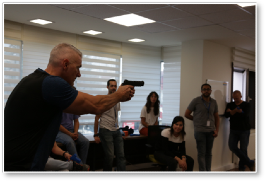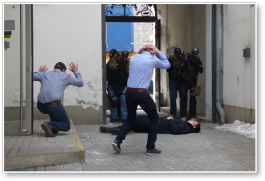IN-PERSON TRAINING
SURVIVING AN ACTIVE SHOOTER TRAINING
ACTIVE SHOOTER THREATS EVOLVE AND SO SHOULD YOUR TRAINING!
Imagine for a moment, you stroll into work like any other day. You grab your morning cup of coffee and move towards your office. As you are about to sit at your desk to tackle the many work objectives for that day, you hear loud bangs down the end of the hall. Your first reaction is ‘What was that? Was that gunshots?’. The situation seems confusing to you and you can’t quite make sense of it. Then, all of a sudden, you hear more loud bangs, followed by screams. You feel sick to your stomach and this overwhelming feeling of panic starts to set in….
Pretty frightening right? Now, while these active shootings are still rare, they are definitely on the increase globally, and while these tragedies bring out the best in some people – they also bring out the worst in others!
When it comes to active shooter training, what we now see are organizations adopting the philosophy of ‘any training is good training’. There are companies, corporations, organizations in the private and humanitarian sectors that are instructing their staff to either watch a 6-minute Run, Hide, Fight video on YouTube, complete a 30min eLearning the organization developed on-line or attend a 2-hour Power Point presentation delivered by one of their security staff.
Now, we all understand that the organization is looking to exert Duty of Care towards their staff but often this becomes a ‘tick the box’ exercise and they just end up regurgitating the same old Run, Hide, Fight mantra without getting across the unpredictability of the situation, the fact you must be constantly re-assessing your position and just because you are doing one of the options doesn’t mean you are not always ready to employ one of the others.
Real Duty of Care would be providing much, much more than the 3 training options above.
Initially, when the active shooter incident erupts, you will naturally be in a reactive state. You didn’t know it was coming, and at the first sound of gunfire, you must react. The goal is to become proactive as soon as possible and this should be the focus of your Active Shooter Training.

INGO – Islamabad, Pakistan

UN – Amman, Jordan

INGO – Kabul, Afghanistan
FIVE CRUCIAL FACTORS YOUR ORGANIZATION SHOULD CONSIDER!
At Prosectra, we believe there are 5 crucial factors your organization should consider when deciding on Active Shooter Training for staff:
1.The Active Shooter Training needs to teach critical thinking skills!
Survival Mindset is key to dealing with – and overcoming – any type of critical incident. Telling staff to ‘be aware of their surroundings’ and ‘keep your head on a swivel’ just doesn’t cut it. Spending the last 15 years researching this very subject, I believe there are 5 components to having a survival mindset:
- Understand the threat: What does the shooter require in order to be successful? The Active Shooter Training should contain detailed analysis of actual shooting incidents, where staff can walk in the shoes, look through the eyes of an active shooter. If conducted for the office building, the training should have staff discover strengths and weaknesses of their office building in relation to an active threat. But don’t just tell them, have them go through the exercise themselves.
- Developing Situational Awareness: Again, this should be learnt through exercise. How do we establish baselines for our environment? What type of anomalies or pre-attack indicators do we look for? How do we create action plans?
- Trusting Intuition: Human beings are the only creatures on the planet that have learnt to down play their intuition. Understanding its importance is crucial when moving towards action.
- Dealing with Denial: This is the ‘Not me, Not here, Not now, Not them’ type of thinking. Denial delays action and in a situation when seconds can be the difference between life and death, understanding this type of negative thinking is crucial. Normalcy Bias and Social Proof are the biggest factors in delaying action. Remember we need to be proactive as quickly as possible. Curling up under a desk, hiding and hoping, crying ‘this can’t be happening, this can’t be happening’ isn’t being proactive.
- Managing Fear: I still can’t believe that there are so many training courses out there on active shooter threats that do not incorporate exercises on managing the fear response. If you’re frozen with fear, it doesn’t matter what your skill set is, it’s like being dead or unconscious…. you’re not moving! Fear management is a crucial factor in creating action. Your training must give you tactics on how to move through the initial fear spike.
2.The Active Shooter Training needs to be physically and mentally engaging!
No one wants to listen to hours of boring statistics that may or may not apply to them. The active shooter training should not be a death by PowerPoint training! Participants learn and retain information mostly by doing. Therefore, the training should contain Walk through – Talk through exercises where participants go through their building and discuss different scenarios.” If you heard gunfire now, where could you escape to?”, “How can you best barricade this room?”, “What is your plan to attack if a shooter enters the room” etc. This then becomes considered learning in a safe environment, where suggestions and plans are implanted when the brain is in a rational mode. This will allow for easier recall of the skills and knowledge in a crisis.
3.The Active Shooter Training needs to be relevant to the country context!
The tactics, techniques and procedures of active shooters varies from country to country. The modus operandi of active shooters in Europe may be very different from those in Africa or the US. The training must contain relevant information regarding the country context the operation is working in. Are you more likely going to be faced with a lone gunman who has a grudge against the organization or a terrorist group carrying out their ideological or political agenda?
4.The Active Shooter Training simulation drill needs to be realistic!
The final simulation drill needs to evoke some sort of confusion and uncertainty but should never be designed to just shock and create fear. The training drill should allow participants to put everything they learnt into practice. It is a simulation after all and it should be an opportunity for participants to feel the pressure of needing to make critical split-second decisions without turning them into a panic-stricken mob. The training drill needs to emphasize the importance of moving and being proactive in your strategy for survival. Moving towards cover, escaping the danger zone, denying the shooter access to kill you, barricading yourself successfully in a room, coordinating a small group to tactically take out the shooter are all examples of exercises the participants would have completed during their Walk through – Talk through exercises. Now the only differences are it’s not choreographed, and they need to decide instantly what is their best option for survival.
5.The Active Shooter Training needs to be a memorable experience!
Far too often I hear of organizations that bring in instructors who teach what they think makes them look cool (or tacticool) and not teaching what the participants really need. The Active Shooter training must be highly interactive and physically engaging with a strong emphasis on learning by doing. That’s how us humans learn best…by putting in the repetitions. The objective of the training should be to increase the safety and survivability of staff before during and after an active shooting. Participants must retain the information! If in the unlikely event they find themselves facing an active threat, they quickly need to asses, decide and then act. Too many times I have asked people who have completed a training provided by their organization (maybe only weeks before) what was the most memorable or useful piece of information from that training and they can’t tell me. If the training is interesting, interactive, fun and engaging then participants are more likely to keep that information with them for the rest of their life…and more often than not, pass that information onto friends and family, reinforcing the learning process yet again.

UN – Ankara, Turkey
ARE YOU PREPARED?
Active shooter incidents are often unpredictable and evolve quickly. In the midst of the chaos, anyone can play an integral role in mitigating the impacts of an active shooter incident. Most organizations are not adequately prepared to protect their personnel from these types of consistently rising threats. Is your workplace one of them?
YOUR UNIQUE ORGANIZATION
PROSECTRA understands that your organization is unique, and your Surviving an Active Shooter Training (SAS-T) should therefore be designed for you specifically. Prosectra have delivered Surviving an Active Shooter Training workshops to organizations in Turkey, Jordan, Afghanistan, Pakistan, UAE, Kenya, Uganda, Ivory Coast, Nigeria and the USA. Our training is created to be effectively taught in a short amount of time no matter what experience you have:
- The course is created by an expert on active shooter survival, with active shooter training.
- “Critical window” training focused on the initial moment the shooting starts to when the shooter is stopped or the Police arrive.
- The program comes with professional step by step workbook and office poster.
- The PROSECTRA Surviving an Active Shooter Training (SAS-T) is an international training curriculum taught around the world.
COURSE OBJECTIVES
PRE-STUDY ELEARNING: The objectives of the pre-study elearning module is to:
- Bring all participants to the same level prior to the practical workshop
- Increase the overall level of awareness of the threat
- Give a basic understanding of your survival responses
PRACTICAL WORKSHOP: The objectives of the practical workshop are to:
- Increase awareness of your overall security readiness
- Develop a better understanding of the Active Shooter threat
- Understand the characteristics of the individuals carrying out mass shootings
- Better understand the incident by analyzing real life events
- Understand the Active Shooter threat specifically for your country
- Develop a better awareness of your office strengths and weaknesses
- Develop a survival mindset for all emergencies
- Develop survival strategies for an active shooting
- Understanding that “MOVE” is your only option whether escaping, barricading or fighting back
- Learn to develop Action Plans whether alone or within a group
- Develop an understanding of firearms & cover vs concealment
- Learn how to behave when security forces arrive
- Put theory into practice within your office when faced with an Active Shooter
START AT HOME!
PROSECTRA has developed the world-leading eLearning module Surviving an Active Shooter. Blended learning is that perfect combination of our online eLearning content and in-person skills sessions. This allows PROSECTRA to deliver a blended learning program. It starts with pre-study eLearning, ensuring all students have achieved a minimum standard and start at the same level.

EVOLVE IN THE CLASSROOM!
The classroom theoretical session contains presentations, analysis, open discussions, individual exercises and group work. The focus is to increase awareness of the Active Shooter threat, develop a survival mindset to make the right first critical decision and what options are available to increase survival whether the Active Shooter is outside the building, inside the building or entering your office location.

FINISH WITH AN EXERCISE!
Our walk-through / talk-through exercise, takes participants through their building where we discuss different scenarios. ”If you heard gunfire now, where could you run to?”, “How can you best barricade this room?”, “What is your plan to fight if a shooter enters the room” etc. This then becomes considered learning in a safe environment, where suggestions and plans are implanted when the brain is in a rational mode. This will allow for easier recall of the skills and knowledge in a crisis.


